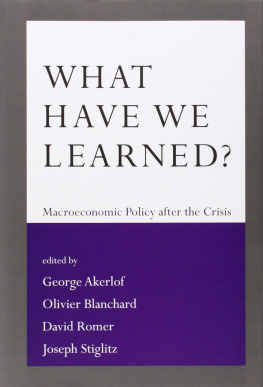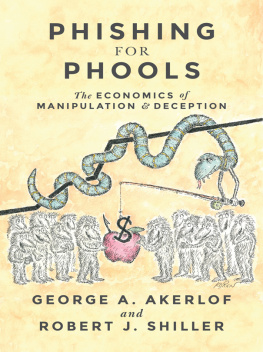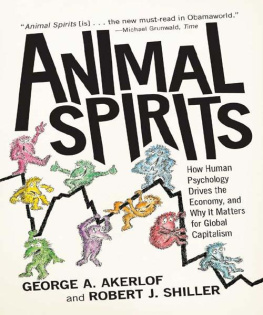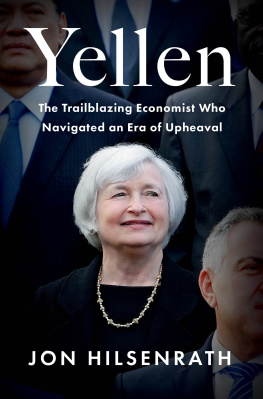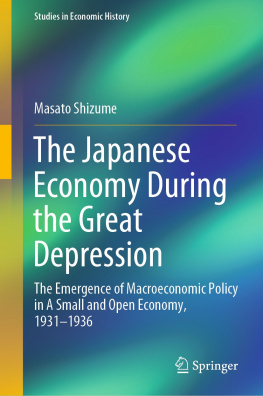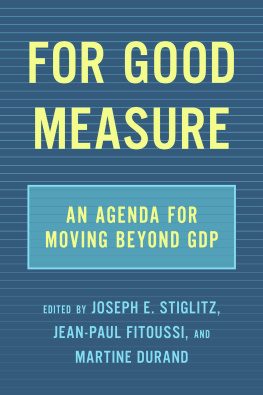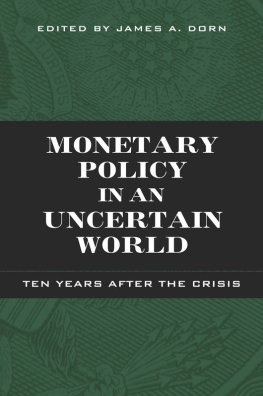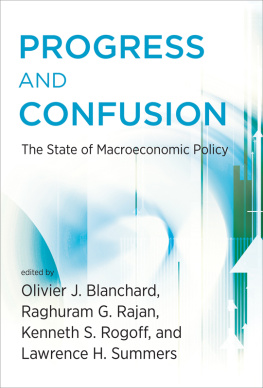Macroeconomic Policy after the Crisis
edited by George Akerlof, Olivier Blanchard, David Romer, and Joseph Stiglitz



Olivier Blanchard, Giovanni Dell'Ariccia, and Paolo Mauro
Part I: Monetary Policy
Janet L.Yellen
Lorenzo Bini Smaghi
Mervyn A.King
Michael Woodford
Part II: Macroprudential Policy
Andrew Haldane
Claudio Borio
Stanley Fischer
Choongsoo Kim
Part III: Financial Regulation
Sheila Bair
Jeremy C.Stein
Jean Tirole
John Vickers
Adair Turner
Part IV: Fiscal Policy
Janice Eberly
Anders Borg
Roberto Perotti
Nouriel Roubini
Part V: Exchange Rate Arrangements
Agustin Carstens
Jay C.Shambaugh
Martin Wolf
Gang Yi
Part VI: Capital Account Management
Duvvuri Subbarao
Jose De Gregorio
Marcio Holland
Helene Rey
Part VII: Conclusions
George A.Akerlof
Olivier Blanchard
David Romer
Joseph E.Stiglitz
Olivier Blanchard, Giovanni Dell'Ariccia, and Paolo Mauro
The 2008-2009 global economic and financial crisis and its aftermath keep forcing policymakers to rethink macroeconomic policy. First was the Lehman crisis, which showed how much policymakers had underestimated the dangers posed by the financial system and demonstrated the limits of monetary policy. Then it was the euro area crisis, which forced them to rethink the workings of currency unions and fiscal policy. And throughout, they have had to improvise, from the use of unconventional monetary policies, to the provision of the initial fiscal stimulus, to the choice of the speed of fiscal consolidation, to the use of macroprudential instruments.
We took a first look at the issues a few years ago, both in a paper (Blanchard, Dell'Ariccia, and Mauro 2010) and at an IMF conference in 2011 (Blanchard et al. 2012). There was a clear sense among both researchers and policymakers participating in the conference that we had entered a "brave new world" and that we had more questions than answers. Two years later, the contours of monetary, fiscal, and macroprudential policies remain unclear. But policies have been tried and progress has been made, both theoretical and empirical. This introduction updates the status of the debate. It was prepared for a second conference that was hosted by the IMF on the same topic in spring 2013 and as a springboard for further discussion.
A few observations on the scope of the analysis: our comments focus on the design of macroeconomic policy after the global economy emerges from the crisis rather than on current policy choices, such as the design of exit policies from quantitative easing or the pros and cons of money-financed fiscal stimulus. The two sets of issues are obviously related, but our objective is to analyze some general principles that could be used to guide macroeconomic policy in the future rather than to suggest specific measures to be taken today. We also take a relatively narrow view of macroeconomic policy, leaving out any discussion of structural reforms and financial regulation. Although the border between financial regulation and macroprudential policies is fuzzy, we concentrate on the cyclical component of financial regulation rather than on the overall design of the financial architecture.
This introduction is organized in three main sections: monetary policy, fiscal policy, and-what may be emerging as the third leg of macroeconomic policy-macroprudential policies.
1. Monetary Policy
The monetary policy theme that emerged from the first conference on rethinking macro policy, held in March 2011, was that central banks had to move from an approach based largely on one target and one instrument (the inflation rate and the policy rate, respectively) to an approach with more targets and more instruments. Two years later the choice of both the set of targets and the set of instruments remains controversial.
A.Should Central Banks Explicitly Target Activity?
Although the focus of monetary policy discussions has been, rightly, on the role of the financial system and its implications for policy, macroeconomic developments during the crisis and after have led to new questions about an old issue, the relation between inflation and output, with direct implications for monetary policy.
One of the arguments for the focus on inflation by central banks was the "divine coincidence" aphorism: the notion that, by keeping inflation stable, monetary policy would keep economic activity as close as possible (given frictions in the economy) to its potential. So, the argument went, even if policymakers cared about keeping output at potential, they could best achieve this by focusing on inflation and keeping it stable. Although no central bank believed that divine coincidence held exactly, it looked like a sufficiently good approximation to justify a primary focus on inflation and to pursue inflation targeting.
Since the crisis began, however, the relation between inflation and output in advanced economies has been substantially different from what was observed before the crisis. With the large cumulative decline in output relative to trend and the sharp increase in unemployment, most economists would have expected a fall in inflation, perhaps even the appearance of deflation. Yet in most advanced economies (including some experiencing severe contractions in activity), inflation has remained close to the range observed before the crisis.
As a matter of logic, there are two interpretations of what is happening. Either potential output has declined nearly as much as actual output, so that the output gap (the difference between potential and actual output) is in fact small, thus putting little pressure on inflation, or the output gap is still substantial but the relation between inflation and the output gap has changed in important ways.
With regard to the first interpretation, it is possible that the crisis itself led potential output to fall, or that output before the crisis was higher than potential output-for instance, if it was supported by unsustainable sectoral (housing) bubbles-so that the actual output gap is small. This could explain why inflation has remained stable. Empirically, however, it has been difficult to explain why the natural rate of unemployment should be much higher than before the crisis, or why the crisis should have led to a large decline in underlying productivity. And although there is a fair amount of uncertainty around potential output measures (especially in the wake of large shocks such as financial crises), by nearly all estimates, most advanced economies still suffer from a substantial output gap.
This leads to the second interpretation. Indeed, convincing evidence suggests that the relation between the output gap and inflation has changed. Recent work (e.g., the IMF's 2013 World Economic Outlook report) attributes the change to the following two factors.

